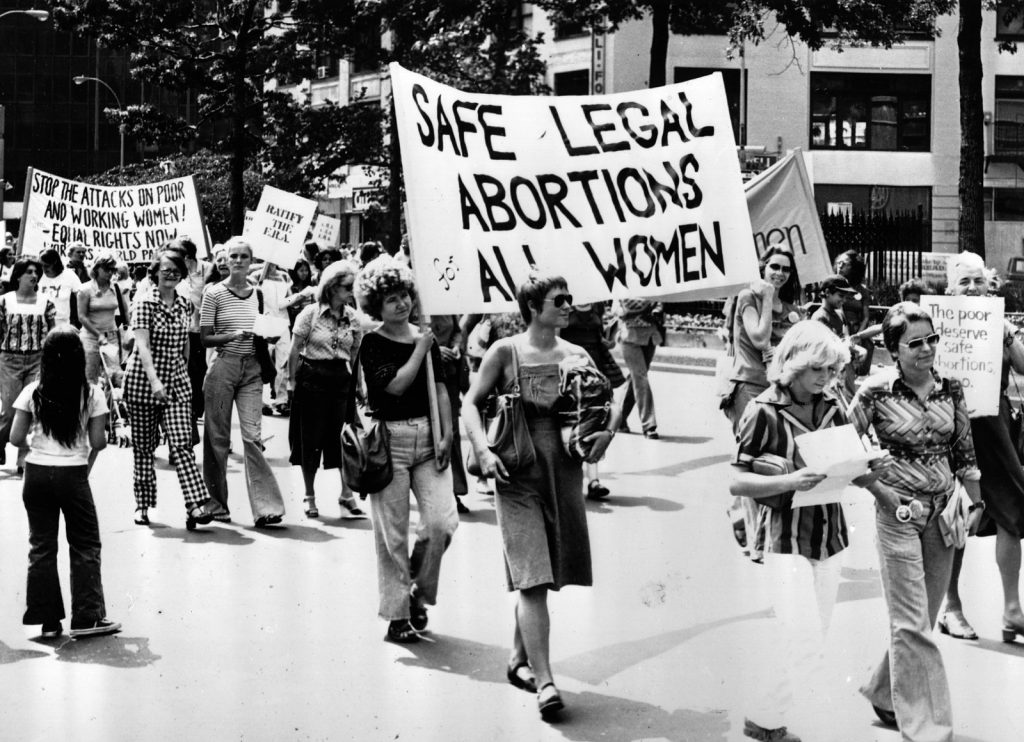On April 25, 2004, upwards of a million people protested the Bush administration’s attacks on reproductive rights in a march on Washington. A mile-long crowd of protestors in purple shirts filled the space between Capitol Hill and the Washington Monument to listen to Democratic politicians, celebrities, abortion movement leaders, and other high-profile figures speak in defense of legalized abortions. At the time, the March for Women’s Rights was the largest demonstration for reproductive rights in the history of the United States. While it was far from radical — both Hillary Clinton and Gloria Steinem spoke, and the name itself ignores the fact that trans men and nonbinary folks also get abortions — the march at least showed the importance and power of a mass demonstration.
Eighteen years later, and the current abortion rights movement seems to have forgotten that lesson. The organizations that planned the 2004 march — the Feminist Majority Foundation, NARAL Pro-Choice America, the American Civil Liberties Union, Black Women’s Health Imperative, the National Latina Institute for Reproductive Health, the National Association for Women, and Planned Parenthood — need to once again put all their money and organizational resources together in order to mobilize their bases in support of reproductive rights. We need another mass march for abortion rights now. But we need more than a one-off march if we are really going to win and defend the right to an abortion and other reproductive rights. A mass march is just the starting point of what should be a mass movement that brings together feminist groups, healthcare worker unions, and leftists to defend Roe v. Wade and win free abortion for all on demand.
Reproductive Rights: Then and Now
Let’s be clear: George W. Bush carried out major rollbacks on reproductive freedom. On his very first day in office, he reinstated the Global Gag Rule, which bars funding to international family planning organizations that provide, or even talk about abortion. He signed the so-called Partial-Birth Abortion Ban Act in 2003, which banned “dilation and extraction” abortions, and the horribly named 2004 Unborn Victims of Violence Act, which classifies embryos and fetuses as victims if an act of violence is committed against a pregnant person.
Feminist Majority and the six other organizers of the march correctly responded to the Republican president’s actions by working for almost a year to mobilize their bases to march on Washington D.C. They were hoping the sheer number of demonstrators would “send a wake-up call” to people across the country that abortion rights were under attack. It was indeed a show of force. But to really beat back the abortion restrictions, it needed to kick off a mass movement for abortion rights, not just a one-time march that was meant to act as a push to the polls in the year of a presidential election.
In fact, Cinton herself said the following during the 2004 march:
We didn’t have to march for 12 long years because we had a government that respected the rights of women. The only way we’re going to be able to avoid having to march again and again and again is to elect John Kerry president.
It’s no coincidence that this march took place during the year of a presidential election and during the Bush administration. It was a way for them to mobilize their base to vote for John Kerry in the upcoming election.
This strategy didn’t work. Much more is needed to effectively block right wing attacks on abortion rights.
Since 2004, many states under Repubican control have enacted restrictions on abortions. Examples include mandatory waiting periods and targeted restrictions on abortion providers (TRAP) laws, that place medicaly unnecessary restrictions on abortion access. According to the Guttmacher Institute, as of December 2021, 33 states have mandatory counseling, 26 have mandatory waiting periods, and 21 states require at least one parent to consent to minors receiving abortion services. This year on September 1, Texas Senate Bill 8 went into effect, banning abortions after six weeks by leveling a bounty on anyone who gives, receives, or even drives someone to an abortion in the state of Texas. These laws have all but taken away the right to an abortion around the country. On December 1, the Supreme Court heard oral arguments in Dobbs v. Jackson Women’s Health, in which the conservative majority suggested they would uphold Mississippi’s ban on abortion after 15 weeks.
There is a real chance that Roe v. Wade will be overtturned in 2022, moreso than in 2004 — we are more poised to see a de-facto or legal overturn of Roe v. Wade, and therefore, the right to an abortion around the country. Yet the seven pro-abortion organizations who planned the 2004 march don’t seem to think that the the situation is dire enough to again mobilize their bases and take to the streets in a mass demonstration. While there have been several smaller rallies and marches organized in response to the court’s actions — most notably, the October “Bans Off Our Bodies” National Day of Action that Planned Parenthood and the ACLU helped organize — these events were much smaller than the 2004 March for Women’s Lives and much smaller than the 2017 Women’s March. Together, the 600 demonstrations held around the country on October 2 might have pulled in numbers similar to the 2004 march, but none individually amassed more than several thousand attendees. And the messaging in 2021 was anarchronistic, focused on an anti-Trump message as if the Democrats don’t control the Congress and the Executive branch. And the message was entirely devoid of urgency. The October 2 protests did not demonstrate the overwhelming support for legalized abortions in America—59% of adults support legal abortion now.
Instead of marching, the nonprofits that organized the 2004 march have attempted to mobilize their bases around donating to abortion funds and the organizations themselves. Click on the Reproductive Freedom tab on the ACLU website and a huge “Fight Unconstitutional Abortion Bans” banner pops up with a link to donate to the ACLU. The message on the NARAL Pro-Choice landing page — and the Take Action page — reads, “Our reproductive freedom is on the line. We’re giving this fight everything we’ve got. But we need your help. Can you vote for NARAL to win a grant from CREDO Mobile?”
Interspersed with the constant calls for donations are calls for people to “vote” or to contact their senator and pass the Women’s Health Protection Act — legislation meant to protect the right to an abortion. The ACLU, NARAL, and the National Latina Institute for Reproductive Health have all focused on calling on Senators to pass this bill. The Take Action page on the ACLU website leads to an email template: “Send a message to your senators urging them to pass WHPA.” These organizations cannot possibly believe this is a real way to fight for abortion rights. Yet they amass millions in donations by people who place their hopes in these organizations to fight for them.
This is, of course, when they’re trying to mobilize their bases at all. The overwhelming response to Dobbs v. Jackson Women’s Health Organization by the seven organizations who once planned the largest pro-abortion march in the country has been to post tweets and issue press releases condemning the Supreme Court’s actions. These press releases are couched in vague language that does not adequately outline what steps these organizations are going to take in response to the anti-abortion legislation. “The Supreme Court must uphold the rule of law, affirm the precedent established by Roe, and protect our Constitutional right to abortion care,” NOW wrote in response to Dobbs. “Anyone – healthcare providers, friends, well-meaning strangers – seeking to help women do what is best for their health… beware. There’s a $10,000 bounty on your kindness,” Black Women’s Health Imperative wrote in response to Texas’s SB-8. (As of this writing, BWHI has not addressed Dobbs on their website or social media accounts.)
The seven organizations that organized the 2004 march are essentially offering three ways to counter the fight on abortion rights: donate, call your senator, or do nothing and ask the Supreme Court nicely not to take away abortion rights. In an interview on the podcast “At Liberty,” Jennifer Dalven, Director of the ACLU Reproductive Freedom Project, was asked if there was a future for pro-choice activism outside of the courts. Dalven said: “We will have to turn to the political strategies. We will have to turn to electing representatives that actually represent us.” It’s clear: they are funneling people’s anger at the current political climate toward electoral politics — even though the Democrats already control both houses of congress and the presidency and Nancy Pelosi herself said Democrats don’t have to be pro-choice. Last year, the Democrats did nothing to stop the confirmation of Amy Coney Barrett, allowing there to be a 6-3 conservative majority on the Supreme Court. Early in Obama’s term the Democrats had a supermajority in Congress, and have not passed any abortion legislation, neither have they passed any legislation with their current majority in Congress.
The Democrats are the graveyard of social movements and this is just one more example of how this works. As one sign from the 2017 Women’s March states, “If Hillary was President We’d Be at Brunch.” But the problem isn’t the attitude of individual liberals; it’s that the organizations that have the power to mobilize millions of people are choosing not to do so.
The Way Forward is to Build a Mass Movement
The future for pro-abortion activism isn’t in the Democratic Party or electoral politics. The future of the movement is in the streets. It’s in the organization of a mass march to kick off a mass movement capable of fighting not only for abortion and reproductrive rights, but for free healthcare, childcare, and parental leave as well. The ACLU, Planned Parenthood, Black Women’s Health Imperative, National Latina Institute for Reproductive Health, Feminist Majority, NARAL Pro-Choice, and NOW thought a mass march was the correct response to Bush’s abortion policies. Why is now any different? Is the onslaught of anti-abortion legislation not enough? Is the bounty on anyone who helps another person get an abortion in Texas not enough? Is the possible overturning of Roe v. Wade not enough?
These seven organizations again need to mobilize their bases to fight for reproductive freedom. The activists and supporters of these organizations need to call on these organizations directly to mobilize in the streets. We also need them to be joined by healthcare worker unions and other unions who understand that abortion is healthcare and healthcare is a right. We need another mass protest that showcases the power of the working class and the popularity of the struggle for abortion rights.
But we cannot leave the future of the movement in the hands of these non-profits that have already shown that they are more concerned with electing Democrats than supporting abortion rights. We need activists to organize open meetings to discuss and vote on next steps to really defend abortion rights. This is the strategy that worked for the abortion rights movements in Argentina and Ireland. We need to bring together healthcare workers, the Black Lives Matter movement, and labor unions — all have a role to play. The right to free, legal, accessible abortion on demand for all will not be won in the courts or at the ballot box. It will be won in the streets.










